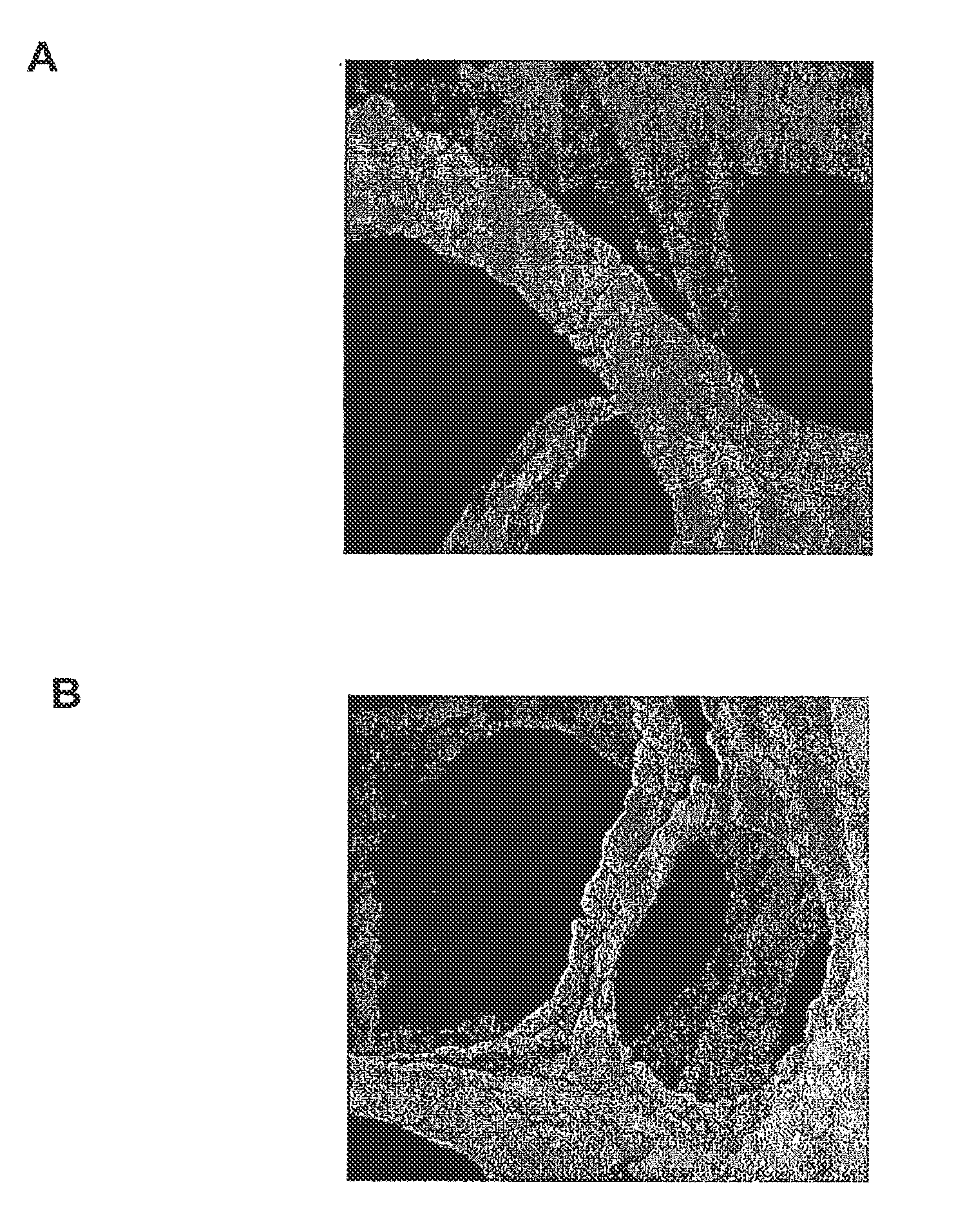Metal Oxide Scaffolds
a technology of metal oxide and metal oxide, applied in the field of implants, can solve the problems of reduced bone growth and volume, and brittleness of ceramic coatings, and achieve the effects of improving the condition of bone producing cells, good biocompatibility, and fast bone growth
- Summary
- Abstract
- Description
- Claims
- Application Information
AI Technical Summary
Benefits of technology
Problems solved by technology
Method used
Image
Examples
example 1
[0127]The used slurry consists of an electrostatically stabilized TiO2-suspension without further additives. The components of the slurry are deionised water, TiO2-Powder (batch 1170117, Sachtleben Hombitan Anatase FF-Pharma, Duisburg, Germany) and 1 mol / l HCl (Merck Titrisol, Oslo, Norway). The suspension was set at pH 2.2 by the HCl. In order to achieve an optimal dispersion, the suspensions in the agitator mill, with the ceramic(s) double meal disk were prepared. As grinding bodies 600 g Zirconox CE milling beads (Jyoti GmBH, Drabber, Germany) were used, with a diameter of 0.4-0.7 mm. The production of the slurry was done in the following manners:[0128]1. 118.8 g deionised water with 1.2 g 1 mol / l HCl is placed in a water-cooled container with milling beads.[0129]2. The addition of that the total amount of 210 g TiO2-Powder takes place gradually. The TiO2-Pulver is added into the liquid stepwise with a stirring speed at about 1000 RPM. The suspension's viscosity...
example 2
TiO2 Slurry Recipe with Fluoride Doping
[0135]The used slurry consists of an electrostatically stabilized TiO2-suspension without further additives. The components of the slurry are deionised water, TiO2-Powder (batch 1170117, Sachtleben Hombitan Anatase FF-Pharma, Duisburg, Germany) and 1 mol / l HCl (Merck Titrisol, Oslo, Norway). The suspension was set at pH 2.2 by the HCl. In order to achieve an optimal dispersion, the suspensions in the agitator mill, with the ceramic(s) double meal disk were prepared. As grinding bodies 600 g Zirconox CE milling beads (Jyoti GmBH, Drebber, Germany) were used, with a diameter of 0.4-0.7 mm. The production of the slurry was done in the following manners:[0136]1. 118.8 g deionised water with 1.2 g 1 mol / l HCl is placed in a water-cooled container with milling beads.[0137]2. The addition of that the total amount of 210 g TiO2-powder takes place gradually. The TiO2-powder is added into the liquid stepwise with a stirring speed at about 1000 RPM. The s...
example 3
Scaffold Production-Hot Plate Moulding
[0144]Hot plate moulding is a shaping process which utilises the effect of steam to mould a drop of suspension containing ceramic raw materials into hollow-sphere geometry (FIG. 1). The fluoride-doped TiO2 slurry was prepared (see Example 2) mixed with 6.0 g polyethylene-copolymer powder (Terpolymer 3580, Plastlabor, Switzerland) and 5.0 g phenolic resin powder (FP 226, Bakelite, Germany). A brass plate with spherical depressions was heated to 320° C. Using a 2 ml syringe, a drop of slurry was then given into each depression. Heat transfer from the plate to the drop led to release of steam which then formed bubbles within the drop. Coalescence of these steam bubbles created a large cavity in the centre of the drop, and progressive drying prevented the structures from collapsing. The continuously rising steam pressure finally led to bursting of the still viscous, topmost part of the drop. Surface tension acted to round the rims of this opening. F...
PUM
| Property | Measurement | Unit |
|---|---|---|
| porosity | aaaaa | aaaaa |
| porosity | aaaaa | aaaaa |
| pore size | aaaaa | aaaaa |
Abstract
Description
Claims
Application Information
 Login to View More
Login to View More - R&D
- Intellectual Property
- Life Sciences
- Materials
- Tech Scout
- Unparalleled Data Quality
- Higher Quality Content
- 60% Fewer Hallucinations
Browse by: Latest US Patents, China's latest patents, Technical Efficacy Thesaurus, Application Domain, Technology Topic, Popular Technical Reports.
© 2025 PatSnap. All rights reserved.Legal|Privacy policy|Modern Slavery Act Transparency Statement|Sitemap|About US| Contact US: help@patsnap.com



